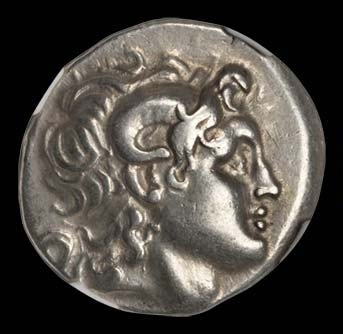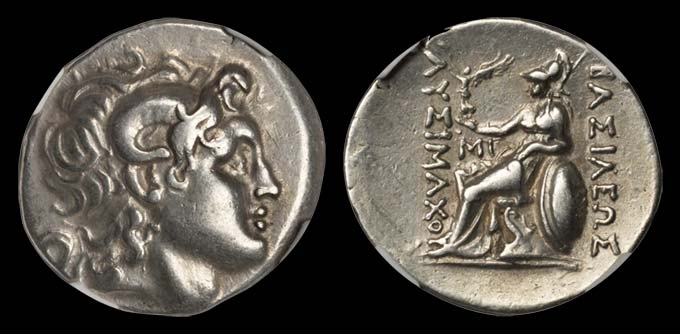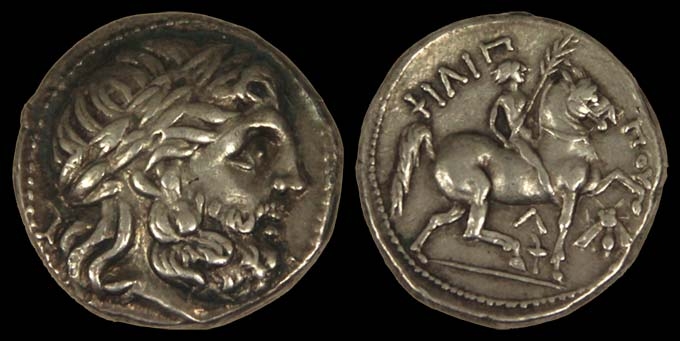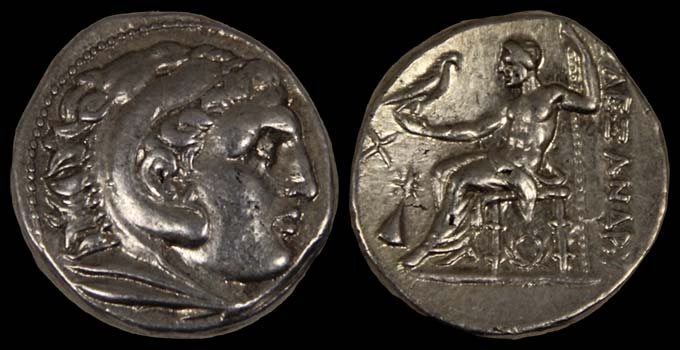Recent Ancient Coin Acquisitions Focus on Alexander the Great

In the last year or so the Museum has continued to add high quality examples to its collection of ancient coins, and some of our most recent acquisitions have been related to Alexander the Great and the kingdom of Macedonia. Simone Edgar Holmes ’20.5, Ancient Art Intern during the 2017–2018 academic year, has lectured on a number of these coins and has written labels for their installation in our Ancient Mediterranean and Early European Gallery. Several highlights are included below.
Lysimachos, Kingdom of Thrace, c. 305–281 BCE
Tetradrachm, silver
Obverse: Diademed head of Alexander the Great with horn of Ammon
Reverse: Athena seated on prow, holding Nike, shield, and spear
Inscription: ΒΑΣΙΛΕΩΣ ΛΥΣΙΜΑΧΟΥ (“of King Lysimachos”)
As his former general and the new ruler of Thrace, Lysimachos used Alexander the Great’s image to assert his own authority. This portrait depicts Alexander with the ram’s horns of Ammon, an Egyptian deity whose oracle entitled Alexander the “son of Zeus-Ammon.” Although it is unknown whether Alexander actually believed he was a god, he was worshipped as one after his death. Lysimachos thus portrays him as both his political predecessor and his patron deity. To connect Alexander’s glory with his own, his reverse features Athena holding Nike, the bringer of victory, crowning the inscribed “of King Lysimachos.”

Philip II, Kingdom of Macedonia, c. 359–336 BCE
Tetradrachm, silver
Obverse: Wreathed head of Zeus
Reverse: Racehorse and jockey, bee in right field
Inscriptions: ΦΙΛΙΠ‐ΠΟΥ (“Of Philip”)
Father to Alexander the Great, Philip II of Macedon’s currency not only promoted the economy, but also functioned as personal propaganda. Always eager to emphasize his Greek origins, he thus honors the chief Olympian god, crowned with laurels, on the obverse. The reverse commemorates his victory at the Olympics of 356 BCE, and alludes to the birth of his son, which reputedly occurred on the same day. Since these coins were produced at a number of royal mints, the bee on the reverse is a mint-mark that indicates the place of issue.

Kassander, Kingdom of Macedonia, c. 317–305 BCE
Tetradrachm, silver
Obverse: Head of Alexander as Herakles with lion’s mane
Reverse: Zeus enthroned, holding eagle and scepter
Inscription: ΑΛΕΞΑΝΔΡΟΥ (“Of Alexander”)
Kassander, king of Macedon and successor to Alexander the Great, was among the first to mint a human, rather than divine, portrait. This tetradrachm is a “posthumous Alexander”: a reproduction of the great king’s own currency, which featured the hero Herakles and the god Zeus. As with Alexander’s coins, the reverse depicts Zeus enthroned, the traditional symbol of royal authority. Kassander’s obverse, however, depicts Alexander in the guise of the hero Herakles, wearing his lion mane. According to ancient historians, Kassander loathed Alexander for publicly beating and humiliating him. Why, then, would Kassander honor his nemesis on his coinage?

